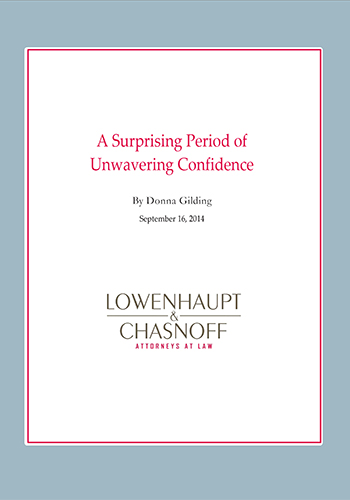A Surprising Period of Unwavering Confidence
By Donna Gilding
Even as the headlines include wars in the Middle East and Eastern Europe, and as the European Central Bank announced further rate cuts, the consensus of our managers is that complacency and confidence continue to exist in the US. For example, none of the following events was greeted with apprehension about overheating or an imminent correction!
- In the four years ending in August 2014, the S&P 500 gained more than 80% and crossed 2000 mark for the first time
- The new jobs numbers for August were disappointing and showed that the US failed to create at least 200,000 new jobs for the first time in seven months.
Last year, even the suggestion of ending of quantitative easing, created a spasm in the global markets. However, once the tapering started, the stock market took it in its stride.
When will the Fed Start Raising Rates?
The general answer seems to be long after the end of the quantitative easing. In the interim, however, we are hearing another argument more and more often: Rising rates need not matter. History shows that stocks keep rallying right up to the start of a rate rise.
Goldman Sachs points out that stocks rallied the year ahead of the first Fed rate rises in the tightening cycles of 1994, 1999 and 2004. However, none of those cycles was preceded by a global financial crisis or the extremely low interest rates we have today. Morgan Stanley has predicted that the S&P 500 could reach 3000 if the economic expansion lasts another five years. Morgan Stanley also points out that consumer confidence is just starting to recover as households have significantly paid down their debt.
Where is the Investor Today?
Investors appear to be taking comfort in the lack of euphoria that has accompanied previous bubbles. The excesses may not be as extreme today as they were in March 2000, but they do exist. One manager noted: “We didn’t have to have euphoria in the equity markets for investors to lose an awful lot of money. Remember the 37%* drop in the S&P 500 index from its peak in 2007.” *NB Calendar year 2008.
In 2007, the problem was that easy credit was pumping up the price of everything from housing to equities. Companies put leverage on their balance sheets to access cash for expansion, share buybacks, etc. Many of the pre-crisis lending practices are already back. They include: covenant-light leveraged loans; dividend recaps, payment in-kind bonds. They also include low yields on both junk bonds and investment grade debt where lending is surging.
We are not seeing any signs of sub-prime mortgages, although sub-prime car loans are increasing. Managers have also reported seeing more share buybacks funded by new debt than they have seen since 2007. They believe that this is good for the shareholders as long as there is sufficient coverage to handle the debt and pay the dividends or costs of expansion.
It is interesting to note that households have the same proportion of their financial assets in shares as they did at the peak in 2007, according to Federal Reserve data. Since 1950, households have had a larger equity exposure only in the bubble years of 1998-2001. Investors still have money on the sidelines.
This week we have seen investors lining up to hear Jack Ma, the founder of Alibaba, promote what could be the largest ever US technology IPO, despite the fact that the shareholder rights of this issue are so weak that Hong Kong refused to allow the company to list. Euphoria or curiosity? Perhaps both and intense marketing. It is scheduled to list on September 18, 2014.
The Bottom Line:
Perhaps the best news is that the market is still unloved by Main Street. Profound disillusionment about the economy, distrust of the stock market and those selling investments drags on. This is believed to be good for the bulls. Bull markets tend not to end until all doubts are lost. Then Wall Street lapses into hubris and Main Street investors start to pile in.
Wall Street hubris may still be here, but Main Street investors have yet to get on board. Until the Fed really does start tightening, and the foundation of this bull market is actually tested, Wall Street will continue to make optimistic prognoses.
To paraphrase Mark Twain, rumors of the death of this bull market may well not be exaggerated; but they have been premature.

